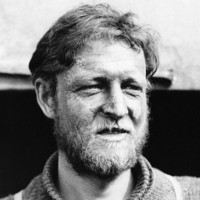Person
ContributeCecil Thomas Madigan was born on 15th October 1889 at Renmark, South Australia, the son of fruitgrower Thomas Madigan and his wife Mary (née Finey), a teacher. He went to Adelaide Boys High School and Prince Alfred College and then to the University of Adelaide, where he studied mining engineering, graduating B.Sc. in 1910. A keen sportsman, he took up rowing and raced in the University eight, which won several championships. He was chosen as Rhodes Scholar in 1911 and went to Oxford University to study geology, but this was interrupted when he was asked by Douglas Mawson to be the meteorologist for the Australasian Antarctic Expedition.
They left Hobart in December 1911 on the S.Y. Aurora, commanded by Capt. Davis, and on 8th January 1912 reached Commonwealth Bay in Adelie Land, where they set up their main camp. Over the next twelve months several excursions were made by sledge into uncharted parts of Adelie Land and King George V Land, with Madigan leading a number of them, including the Eastern Expedition in the summer of 1912-13, which collected important information about the ice and discovered a coal-bearing rock formation. When the Aurora arrived to collect them, Mawson’s party had not returned from its Far Eastern trek and Captain Davis was forced to sail due to deteriorating weather. A relief party, with Madigan in command, remained to wait for Mawson and was forced to wait another twelve months for the ship to return.
They finally reached Adelaide in February 1914 and Madigan was awarded the King’s Polar Medal. He returned to Oxford, but his studies were interrupted again, this time by World War I. He joined the Royal Engineers and served in France, seeing action at the battles of Loos, where he was wounded, and the Somme. He rose to the rank of captain and was twice mentioned in dispatches. He married Wynnis Wollaston, in London, on 20th August 1915, and they had five children.
After the war Madigan returned to Oxford, taking first-class honours in geology. He then spent a year as Assistant Government Geologist in the Sudan in 1920, mapping well-sites and determining new well locations. Returning to Adelaide, he was appointed Lecturer in Geology at the University of Adelaide in 1922, a position he held until his death. He made a significant contribution to the geology of Fleurieu Peninsula in South Australia and the MacDonnell Ranges in the Northern Territory. His book Central Australia (1936) covers his work in the latter region. During this time he pioneered the use of aircraft for scientific reconnaissance and photography.
In 1939 Madigan organized a crossing of the Simpson Desert with nine men and nineteen camels. They left Marree on 25th May and proceeded via Charlotte Waters and Andado to the junction of the Hale and the Todd Rivers, then turned east across the centre of the desert to reach Birdsville on 6th July. It was not, in Madigan’s view, an expedition of enormous moment, but the mystery of the sand ridges, the planning and the physical effort involved attracted him greatly. His expeditionary work was hampered by lack of basic data, particularly maps, but his capacity for organization and survival in extreme conditions more than compensated for this. It was the last classic Australian exploration adventure, vividly described in his book Crossing the Dead Heart (1946).
When World War II was declared, Madigan was asked to develop a School of Military Engineering in Liverpool, New South Wales, and was promoted to lieutenant-colonel. On retiring from the army in 1943, he returned to continue teaching at the University of Adelaide. He was President of the Royal Society of South Australia in 1936 and was awarded its Verco Medal in 1945.
Cecil Madigan died on 14th January 1947 and was buried at Centennial Park Cemetery.
Media
Add mediaImages

Image courtesy of the Australian Antarctic Divsion

Image courtesy of the State Library of South Australia, SLSA: B 20364, Public Domain


Comments
CommentAdd new comment
I would like to know more about his service in ww1 and how he was injured . My Son Euan is looking at famous south Australians that served
I'm curious about 1889 as the date you give for Madigan's birth, particularly if he went to both Adelaide High School and PAC. Adelaide High School did not open until 1908, which suggests that Madigan would have been 19 years old when he attended there. He then wins the Rhodes Scholarship for 1911 and heads off to Oxford suggesting that in 1909 and 1910 he completed his BSc at Adelaide University. Did this mean that he was at PAC before attending Adelaide High in its inaugural year of 1908? There was definitely a Madigan connection to Adelaide High as for many years his sled from Mawson's expedition of 1911-13, which is now a part of the Mawson Collection, was hung from the ceiling from the Staff room in the Grote Street premises of the school.
Hi John, I've only just seen this, and would have to do more research for a full answer, but I believe it is correct that he attended both PAC and Adelaide High. It was more common then for education to be interrupted or for students to start at different times, so it is possible he was older than usual by today's standards.
Dear john, In 1910 he rowed for adelaide uni and i have provided a picture on evolution-path.com/snippets. I am one of the grandsons.
Hello, my name is Euan and i'm doing an assignment on your granfather, i need help and information on his war time and experecience at loos in the war. Thank
Kind regards Euan
Hi Euan, we'd have to go back to the author for more, but you can see the sources used under 'Learn More' (top right). You may also find the War Memorial's guidelines on researching a person useful - https://www.awm.gov.au/collection/understanding-the-memorials-collection...